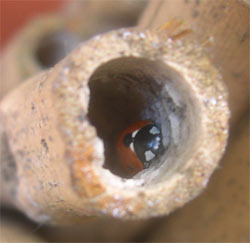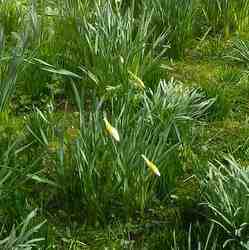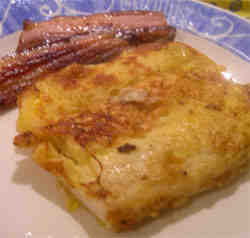A guaranteed investment. Attract overwintering ladybirds to tackle aphids in your garden next year.
Posted by Fiona Nevile in General care | 11 comments Just beside our front door is a small ladybird (ladybug) and lacewing condominium. It’s a simple design that seems to work well. Just a few short lengths of bamboo cane in an old terracotta pot but it does the trick – attracting these aphid eating insects to a warm sheltered spot to hibernate during the chilly winter months.
Just beside our front door is a small ladybird (ladybug) and lacewing condominium. It’s a simple design that seems to work well. Just a few short lengths of bamboo cane in an old terracotta pot but it does the trick – attracting these aphid eating insects to a warm sheltered spot to hibernate during the chilly winter months.
Last year I spotted a selection of rather smart ladybird hotels online. When I saw the price tags I decided to make my own. I had got as far as cutting the bamboo bedrooms and didn’t have time to construct a frame to hold them before the weather started to turn frosty. I realised that if they stood at an angle in a wide necked flower pot that the bedrooms would still provide deluxe accommodation for a discerning bug.
Ladybirds and lacewings are truly beneficial in a garden. They breed prolifically and a female can lay over 2,000 eggs during her life if she has a high protein aphid enriched diet. There is good information on ladybirds, from egg laying to love making on the BBC site. I had no idea that a single ladybird can eat 5,000 aphids during its short life. One thousand ladybirds could eat 5,000,000 on a good day. A ladybird’s life span is just a matter of months so it’s a good idea to try to encourage them to over winter on your plot by providing tempting places to shelter.
Aphids are not so much of a problem here since I started actively providing winter accomodation. And this is not a sophisticated development. Just a few snug B&Bs dotted about the garden.
Like pensioners drawn to winter in The Canaries, they will independantly find warm spots to hole up for the winter. I discover loads sheltering in window frames during the winter months when I’m decorating. As the paint filled brush would mean instant death, I collect them in a match box and bring them home. They’re scattered in a pot of sheep’s wool that is nestled deep in the yew hedge. South or Southwest facing places are best. Even stuffing a tin or a pot with dead leaves can provide shelter for over wintering insects.
Now is the time to act. Once the cold weather sets in they need to have found a warm spot for successful hibernation. Sometimes I see a few ladybirds hibernating on a plant that might catch a little winter sun but will not provide the protection that they need to survive the winter. I use the matchbox trick for these too. They might not like the whistle stop journey to the heart of the yew hedge but they may wake to greet another Spring.
If they’ve survived when the weather warms up, they’ll start laying the eggs that will provide the next generation of ladybirds in the garden. Aphids can decimate plants in a few feast filled days. Ladybirds are the organic answer to tackling this problem.
Leave a reply







I had got as far as cutting the bamboo bedrooms and didn’t have time to construct a frame to hold them before the weather started to turn frosty. I realised that if they stood at an angle in a wide necked flower pot that the bedrooms would still provide deluxe accommodation for a discerning bug.These is great looking forward to read more.